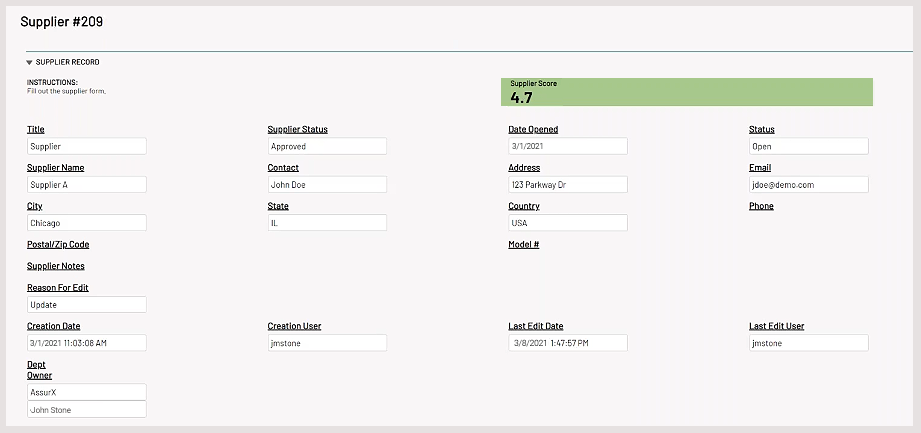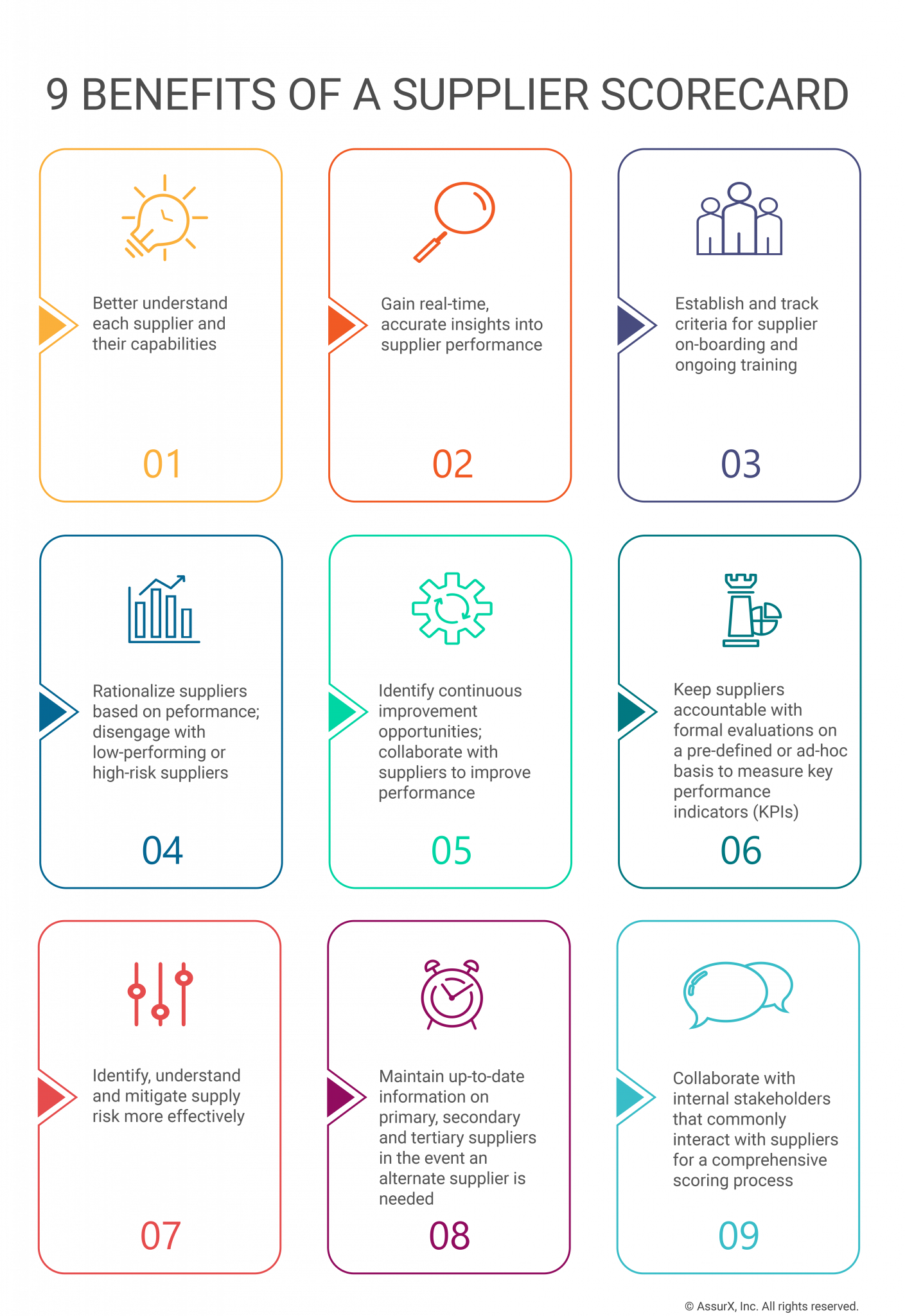April 6, 2021
Imagine if your plant is starting work on a big order. You’ve just been advised that a supplier has placed a key material on backorder. To fulfill the contract with your customer, you’ll need to contract a different vendor, but your top-tier suppliers are booked with orders and can’t meet your deadline. With no option but to look at secondary (or tertiary) suppliers, you need more details than just availability to make the right choice.
That’s where the supplier scorecard comes in.
Within an enterprise quality management system (EQMS), manufacturers can use the supplier scorecard to mitigate risk, benchmark vendors, and manage supplier performance.
These capabilities are especially important in the context of rising prices and widespread shortages amid surging demand. Here we look at elements of an effective supplier scorecard, how to score them, and considerations for getting the most from your EQMS supplier quality management solution.
Establishing the Overall Supplier Score
The overall supplier score is one of the most important elements of your supplier scorecard. It provides a quick view of the calculated risk associated with working with a given vendor, making decisions even simpler with color-coded supplier ratings.
For instance, your company might look at your approved supplier list (ASL) and decide that an overall score of four or greater is classified as low risk (green). You might also decide that a vendor with a score of less than two has too many compliance risks (red). For approved suppliers that are classified as (red), you might require certain actions such as:
- Putting incoming material on hold for additional inspections
- Temporarily suspending shipments
- Alerting the procurement team to contact secondary suppliers
- Creating an alert to trigger a follow-up audit with the supplier
Below we discuss some categories of metrics to consider including on your supplier scorecard, as well as specific metrics for each category. Each metric can be rated and weighted based on its relative importance to calculate the overall supplier score.

Figure 1: Sample EQMS supplier record indicates at-a-glance that the supplier is meeting all quality criteria by the scorecard indication of low-risk (green color code) and the corresponding aggregated score of 4.7.
Establishing Supplier Scorecard Metrics
Pre-Delivery
Supplier performance is about more than just whether the incoming product conforms to specifications. For many manufacturers, the supplier scorecard also considers a number of pre-delivery metrics, including:
- Price
- Lead time
- Order entry accuracy
It’s important to note one of the biggest pandemic-related supply chain challenges manufacturers are seeing today is extended lead times. This may factor into how you weigh the metric and pre-delivery metrics in your scorecard. For instance, suppliers providing critical to quality (CTQ) materials should have a heavier weight on these ratings, since missed lead times could have a big impact on the manufacturer.
Supplier Score Card Metric: Delivery
A vendor’s delivery performance can make or break your timing as a manufacturer, determining whether you are able to fulfill your own customers’ expectations. A supplier’s delivery metrics give you an idea of how well they perform in areas such as:
- Delivery accuracy
- On-time performance
- Packaging requirements
- Quantity variance
- Transportation and shipping services
Supplier Scorecard Metric: Post-Delivery
Post-delivery metrics are some of the most important to track within the supplier scorecard, including details related to:
- Non-conforming incoming product
- Informational non-conforming material reports (NMRs)
- Shipment variances
- Price variance
When a nonconforming product is identified, this information can then be linked to the supplier quality management workflow to trigger corrective action and other follow-ups such as changes to supplier audits or quality agreements. Integrating the supplier scorecard in this way gives you a complete view of all quality operations, in near-real-time, reducing risk while making sure problems don’t slip by unnoticed.
Supplier Scorecard Metric: Customer Satisfaction
Supplier risk is about more than just delivery metrics. It’s also about your experience with them as a customer, including how they respond to issues and collaborate with your team. For instance, you might rate each supplier on elements such as:
- Responsiveness: How quickly does the supplier respond to emails and Supplier Corrective Action Requests (SCARs)? How does this compare to how quickly you need the information? How does it compare to your baseline with other suppliers?
- Communication: Does the supplier communicate issues proactively? Do they provide updates on SCAR action items and progress?
Customizing Your Supplier Quality Management Processes
How you weigh each category of metrics will be unique to your business and may change over time. Within the EQMS, you should be able to configure your supplier quality management solution to your needs, including:
- Importing information for each supplier record so you don’t have to waste time doing it manually
- Creating custom drag-and-drop workflows without programming or coding
- Linking audit findings to SCARs and supplier performance records
- Granting limited access to the EQMS so suppliers can view their scorecard and communicate on items such as change requests, deviation responses, and shipment notifications
From a software standpoint, it’s important to look for a solution that doesn’t have a long implementation cycle. This key element is what allows you to use the tools to drive faster improvement and risk mitigation.
Linking Supplier Quality Management to Other EQMS Functions
Supplier quality management doesn’t exist in a vacuum. It’s connected to many different areas of your quality processes and business, making it essential that you can connect supplier quality workflows to areas such as:
- Training to ensure suppliers are up to date with necessary information
- Corrective action processes to find and fix high-risk issues
- Audit management for both internal and external audit findings related to suppliers
- Document management including supplier quality agreements, specifications, and certifications
- Procurement, planning, and finance data to support supplier ratings
- Risk management to incorporate risk as a metric for benchmarking suppliers
- Reporting functions where you can look at trends and analysis of key information such as non-conformance reports, number of SCARs, and late deliveries or shortages
These capabilities give you a single source of truth for all supplier-related data, so you don’t have to pull the information from different systems. In addition, you may wish to include other elements to your scorecard based on your corporate objectives (e.g.: certifications). This big picture view is critical to the visibility into supplier risk, helping avoid problems that can threaten your brand—and allowing you to keep moving forward with full confidence.



